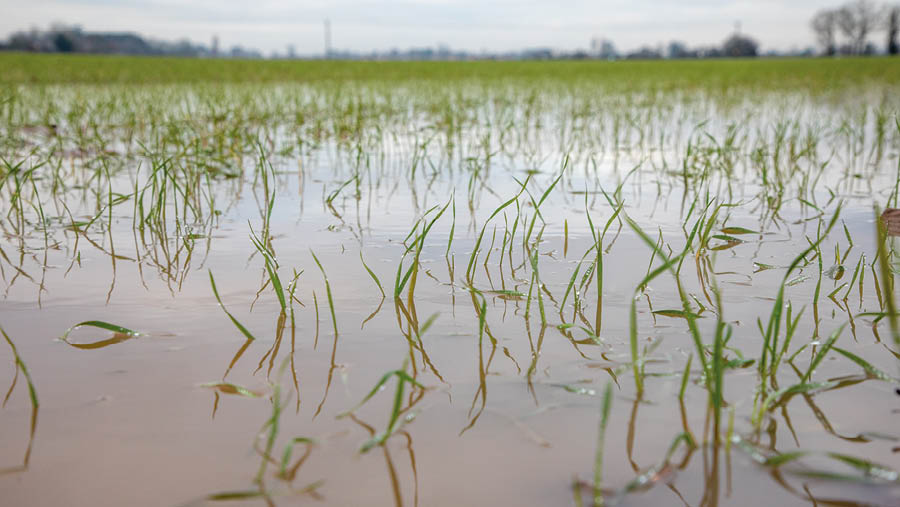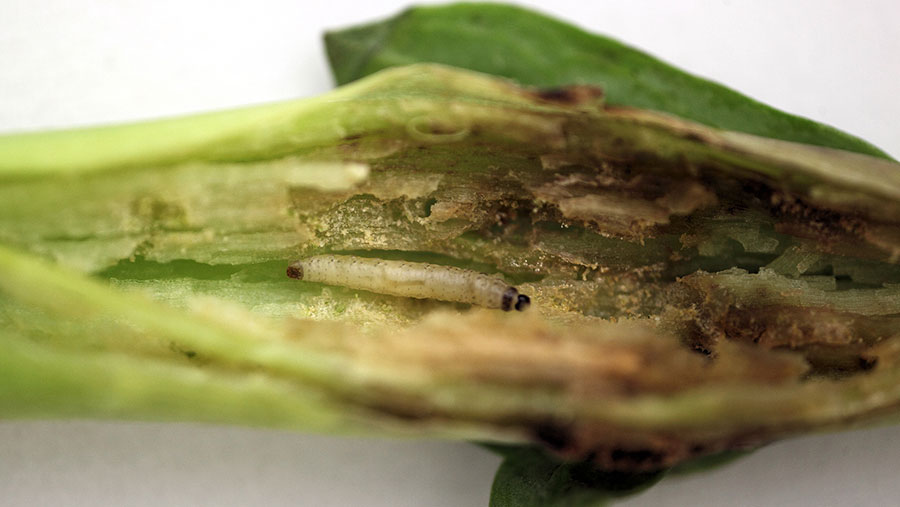Crop Watch: Drowned Scottish crops and rising slug risk
 © Gary Naylor
© Gary Naylor Recent rain has drowned crops, including in Scotland where fields have turned into quagmires. The mild, wet weather could increase the risk of slugs, although some forward cereals crops can withstand some grazing.
North
Mary Munro
AICC/Strutt and Parker (Perthshire)
We have had proper rain this last week, with severe flooding in Fife and Angus and roads closed as a result of the downpour. As I write, the water has not receded enough to assess what damage has been done to winter crops in those areas.
In East Lothian the impact was not so great, but some innocent-looking wheat fields were quagmires to step into and the planned crop walks were hastily curtailed.
Some growers have managed to get Kerb (propyzamide) applied in what was a very short window of opportunity, and these fortunate people can relax, knowing all their spraying tasks are up to date. It looks unlikely that any outstanding sprays will be possible this side of Christmas.
See also: Why farmers need to change the way they use propyzamide
Slugs remain the challenge that cannot be ignored, and they will relish the wet conditions. The majority of wheat crops are beyond the two-leaf stage and will withstand some grazing, but later-sown crops may still be at risk, and a dose of ferric slug pellets may be necessary once it is possible to get across the land.
This is a good time to take stock of the year past and prepare budgets for the season to come. The Scottish government is committed to BPS for a couple more years, and the Agriculture Bill proposes payments that are conditional on various environmental measures.
The direction of travel is very clear, and although broadly aligned to the EU CAP reform, there is far less mention of support for food production in the Scottish document. This, coupled with the demand for land to plant trees on, makes one wonder whether food security registers at all with our policy-makers.
I find it ironic that Scottish farmers are expected to be greener than green, and yet the nation imports cheap food from countries with dubious environmental credentials. Perhaps growing crops for alcohol is a safer bet after all.
South
Jamie Swift
Procam (East Sussex)
November temperatures have been unusually warm, and aphids haven’t been hard to find in cereals. An infection of barley yellow dwarf virus (BYDV) can have an enormous impact on yield, which makes this pest hard to ignore when spotted at these early growth stages.
The recent rain has brought with it some cooler temperatures that will have stopped aphids flying, but my Aphid Assist app has still flagged that T-sum threshold of combined 170 degree-days after crop emergence has been met. Technology such as this to monitor thresholds is really useful in confirming that the use of a pyrethroid is valid.
I’m seeing more blackgrass than I’d like to when on aphid watch, and the aphicide pass will give the opportunity to top-up residual herbicides to maintain persistency into the winter.
OSR weeds
Oilseed rape crops have also seen further flushes of grassweed through late October following clethodim applications. Propyzamide-based products are the go-to here, and as soon as soil temperatures reach 10C and show to be falling, then an application of Kerb will be needed.
Waiting for this green light for Kerb while also being aware of diminishing spray opportunities is always a fine balance, and here’s hoping that soil temperatures reach the ideal level sooner rather than later to avoid grass rooting too deeply for good control of the residual chemistry.
I say this because somewhat of a deluge in recent weeks has drastically limited spraying opportunities, which reminds me of the importance of making good use of spray opportunities before the sprayer and the crops are put to bed for winter.
On the whole, they’ll be entering winter in very good condition, and crops are where I would like them to be as we approach December. Although the early drilling has put pressure on both weed control and aphids, it is encouraging to see so many well-established crops.
West
Antony Wade
Hillhampton Technical Services (Heref/Shrops)
As always, nature has played catch-up and started to make up for the dry summer and early autumn, with a conveyor belt of low pressures providing a regular top-up to rainfall totals since my last time of writing. This has led to limited spray opportunities and some challenging ground conditions in the usual places in some fields.
Luckily, because of our lower grassweed pressure helped by a more diverse rotation, the requirement for a second residual grassweed herbicide application is limited. More recently there have been a couple of interludes in the rain to allow some spraying of late-planted wheat. Any not sprayed now will most likely be on a spring herbicide strategy.
Some of these later crops will not get an aphicide, but based on the lower risk of BYDV infection in crops emerging from mid-October onwards which I believe should be the way, rather than the all-too-easy cover-all prophylactic approach.
We now need the weather to cool down so soil temperatures start to fall and we can get the longevity for grassweed control from the planned propyzamide application to the OSR. Forecasts suggest a return to more normal temperatures rather than the barmy, balmy double-digit values we have recently encountered.
These applications will be combined with a fungicide. In many cases phoma levels have increased with the rain, but stem canker risk in generally fairly large crops will be low, so it will be focused on protection against light leaf spot.
Forward OSR
Some of my largest crops, the “knee wetters”, have had a fungicide with PGR activity to slow down growth, otherwise we will have to get the mowers out early in the new year. If we do have some colder nights with some frost, a few crops will get their first split of bifenox to control some of the charlock, rather than propyzamide.
Barley and oat crops have had their residual herbicide applications for grassweed where necessary. With few contact grassweed options, we now have to hope that these will be effective and crop competition will keep any grassweed impact to a minimum.
Once these outstanding fieldwork jobs are completed it will be time to shut the gate on crops for the winter, although some cereal fields are strong enough that gates may be opened to graze the most forward crops.
With end of autumn applications in sight we are already having to turn our minds to spring fungicide strategies, with the release by Corteva of the application guidelines for Inatreq products for 2023, after some problems with sprayers in 2022.
The sprayer maintenance that will be need to done over winter, plus water volume application requirements, may discourage some from using Inatreq, but for us in the West, where septoria is always our biggest yield-robbing risk, it is a key T2 product.
Indications are that supply for many of the key fungicides will be tight, so we are already having to plan and predict volumes without knowing how the disease pressure will develop in the spring. Oh for that crystal ball!
East
Marion Self
Prime Agriculture (Suffolk)
As mild weather continues into late November we look around and see fields of well-established winter cereals, emerging bean crops and even some good rapeseeds which have continued to grow well in these mild, wetter conditions.
Most of the planned autumn field work is done, and it’s a promising start to the season. However, the autumn has brought its challenges and some of these will follow us into next year.
Where drilling commenced before or during the main weed flush some fields are a bit dirty with volunteers and grassweeds. In September- and October-drilled crops, even robust pre-emergence herbicide stacks and sequences were slow to control grass and broad-leaved weeds in the dry conditions. However, the activity has improved since the rain started and we wait to evaluate their full effect in the new year.
Recent wet and windy weather has also delayed BYDV and manganese sprays, but most crops have now hopefully been treated according to their risk.

© Blackthorn Arable
We also wait to see the impact of cabbage stem flea beetle on rapeseed crops, as small larvae can now be found in the leaf petioles. Slug activity has been relatively low this autumn, but while mild weather persists continue to monitor fields into the winter and protect crops as necessary.
Cover crops
Cover and catch crops have also been affected by the dry start to the season. Some of these were relatively late-drilled while others were planted in the dry and so have been slow to establish. Many have a smaller biomass than in recent years, but I’m assured that even where the above-ground biomass is small the roots will still improve soil structure and biology.
Observe any patterns in cover crop growth across the field as this can indicate areas of soil which need attention; if the covers are struggling, so will the cash crop.
Management policy will vary from farm to farm. But it is usually important to be timely when destroying these covers for many reasons, not least for the green bridge they supply and the slow speed of kill at this time of year.
In rapeseed, conditions for the completion of propyzamide are approaching. These products work best when soils are cool and moist, allowing the actives to be held in the top few centimetres of soil where they are taken up by established and germinating weeds.
Treatments should be carefully stewarded to minimise run-off into surface water; in particular, applications to waterlogged soil should be avoided. This application also provides an opportunity for phoma control, but if mixing grassweed control with a fungicide you will need to apply to a dry leaf.

